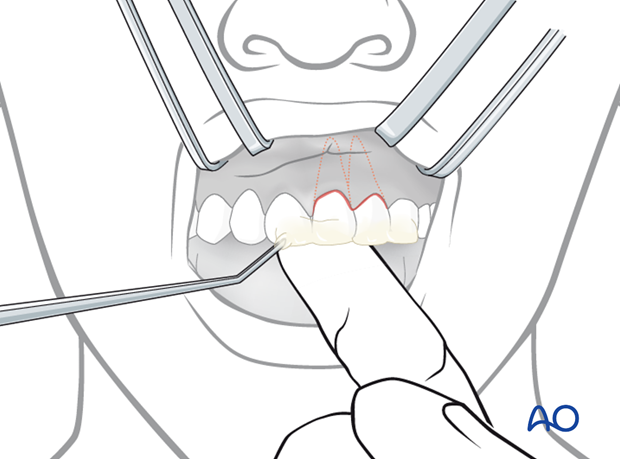Closed treatment
1. Principles
The principles of closed reduction of an alveolar fractures are similar to those of the treatment of a lateral luxation, only the osseous injury is more extensive. Once the teeth are in alignment, the alveolar bone will automatically be repositioned. The subsequent interdental fixation enables fracture healing.
2. Reduction
If exposed, the root surface of the displaced teeth is cleansed with saline solution. The tooth-bearing alveolus is then repositioned with combined labial and lingual digital pressure until its normal position has been reestablished, indicated by alignment of the dental arch in proper occlusion. Strong force for reduction is usually required. In rare cases, forceps may be needed for reduction.

3. Fixation
Fixation is preferably accomplished with a resin splint attached to at least one neighboring intact tooth on each side of the vertical fracture lines.
Soft-tissue repair should precede the splinting of the teeth.
Involved teeth and neighboring healthy teeth are gently dried with compressed air or absolute alcohol and kept dry during the fixation procedure.
Care should be taken that compressed air and absolute alcohol are not allowed to enter the soft-tissue wound.

Points of splint fixation on the repositioned teeth of the fractured alveolus and preferably two neighboring teeth on each side of the fragment are etched with phosphoric acid for 20 seconds.
Remember to place a suction tube to maintain dryness during etching procedure.

The etch gel is removed by saline irrigation. Make sure to direct the saline jet in a direction away from soft-tissue wounds and to place a suction tube to remove the spray of the saline and etch gel.
The fixation spots are then dried.
It is imperative that the enamel be kept dry until the resin has completely set.
A finger on the lingual aspect of the teeth can maintain fragment position during the fixation procedure.

Resin material (eg, that used for temporary crowns and bridges) is applied to provide splinting. The resin material allows a certain flexibility of the splinting and is easy to remove.
Occlusion should be checked, no premature occlusal contacts are allowed.
Alveolar fractures should be fixed for 4 weeks.

Removal of fixation device
After the fixation period (4 weeks), the resin can be peeled off with a dental scaler or removed with a burr. The teeth of the fractured segment of the jaw must be supported by digital pressure during this procedure.

4. Aftercare following treatment of alveolar fractures
Optimal oral hygiene is essential including tooth brushing using a soft tooth brush and mouth rinsing with 0.1 % chlorhexidine twice a day. This is especially important until completion of gingival healing.
In case of undesired signs and symptoms related to the fixation appliance, the patient is encouraged to seek help as soon as possible.
Aftercare includes endodontic treatment in all teeth which develop pulp necrosis.
Follow-up
Occlusion should be regularly checked as a sign of sufficient reduction and fixation.
Diet
Patients are encouraged to restrict themselves to a semi-solid diet and avoid clenching and any other traumatic overload to the traumatized alveolar segment for a period of up to 4 weeks posttrauma.
Further treatment
Further dental treatment may be required as elective procedures, for example management of tooth fractures, discoloration, porcelain restoration, etc.













